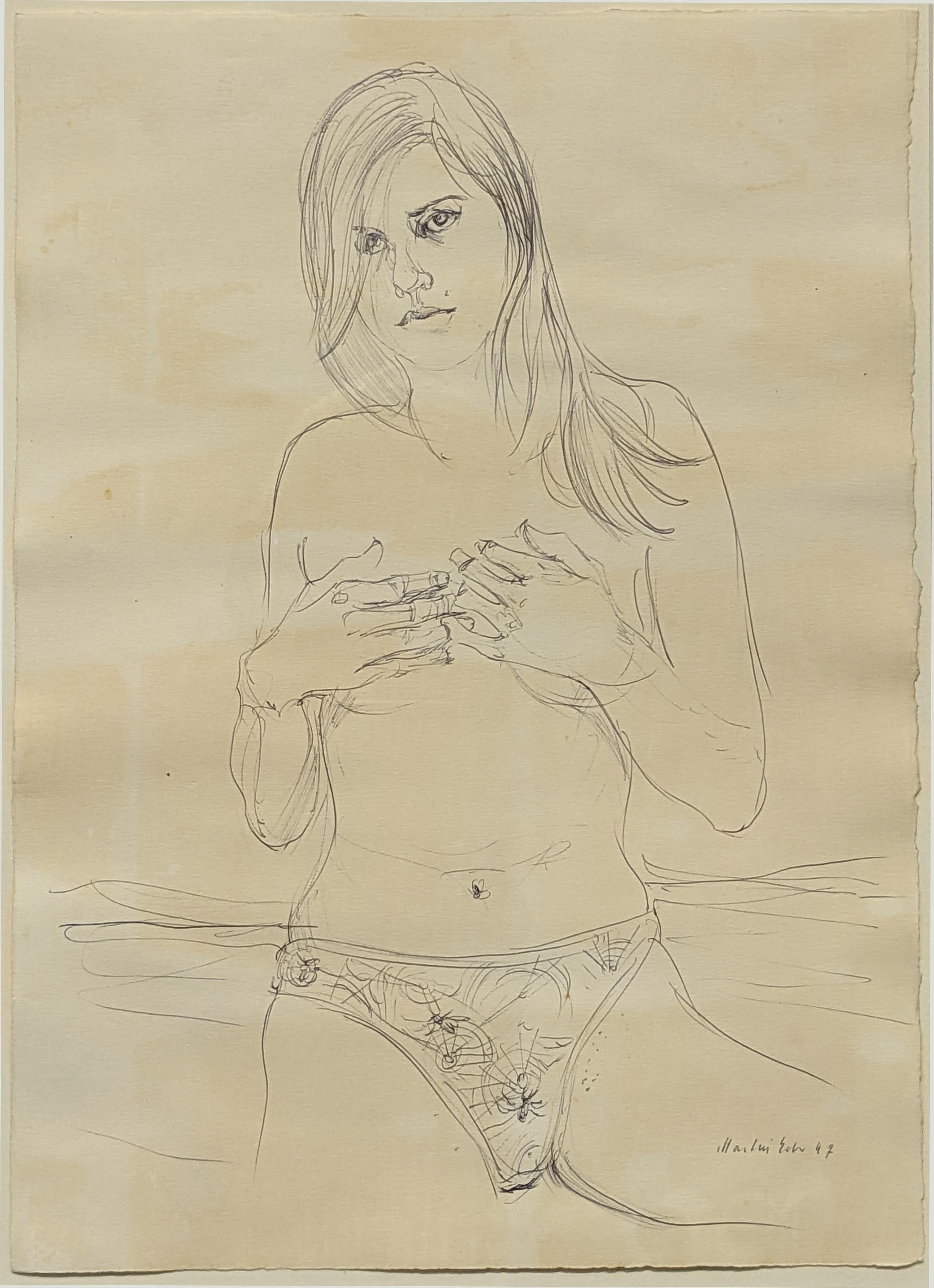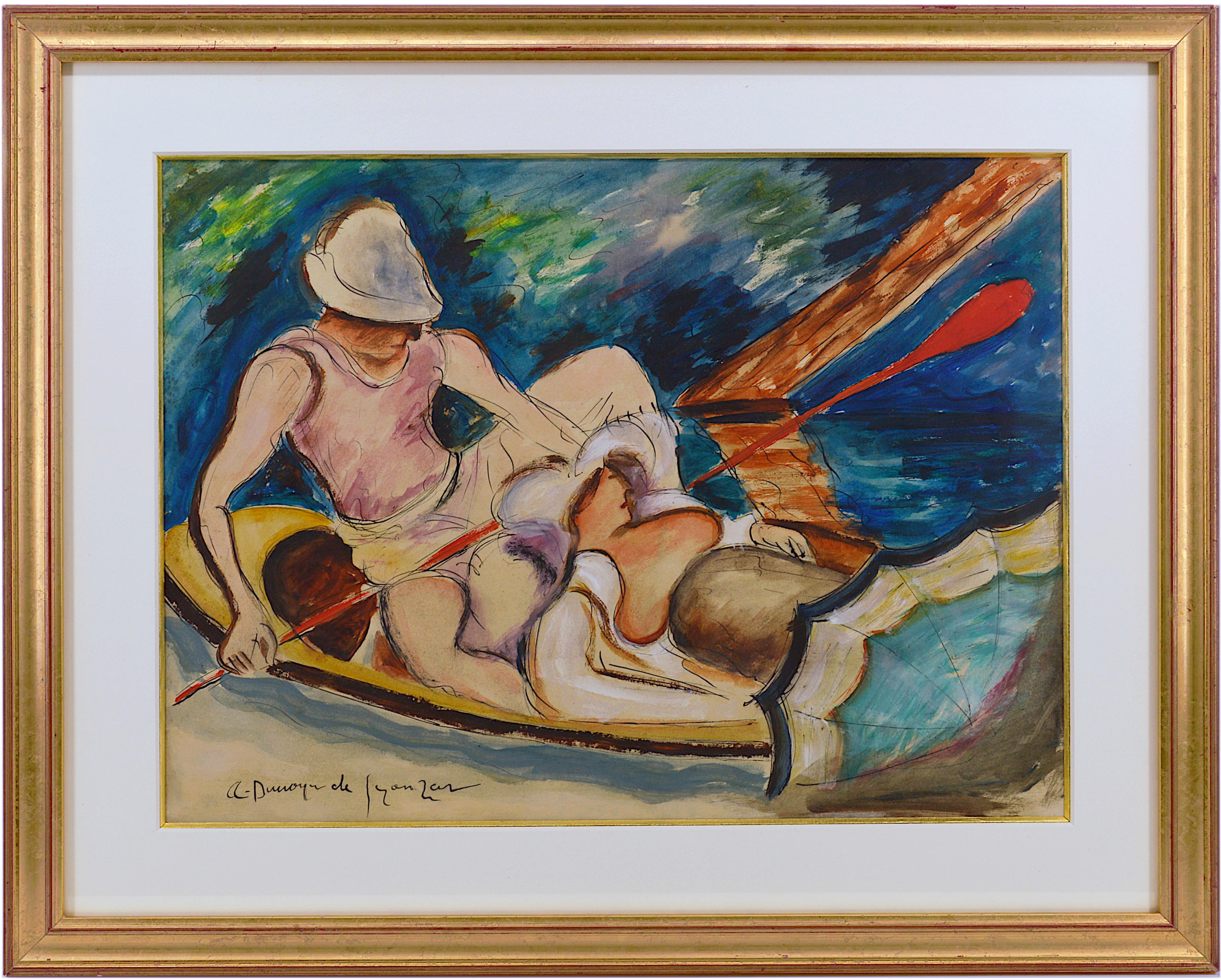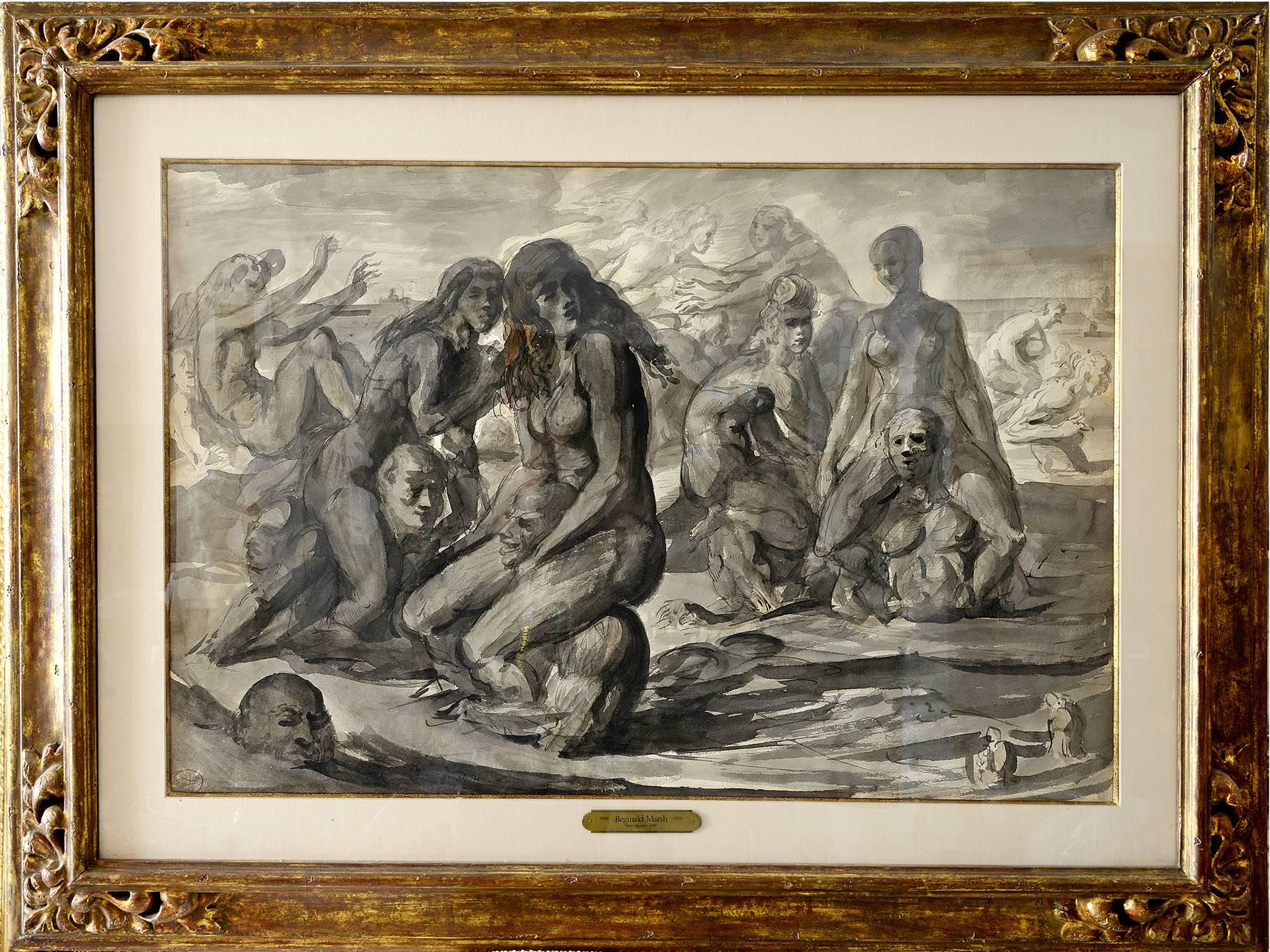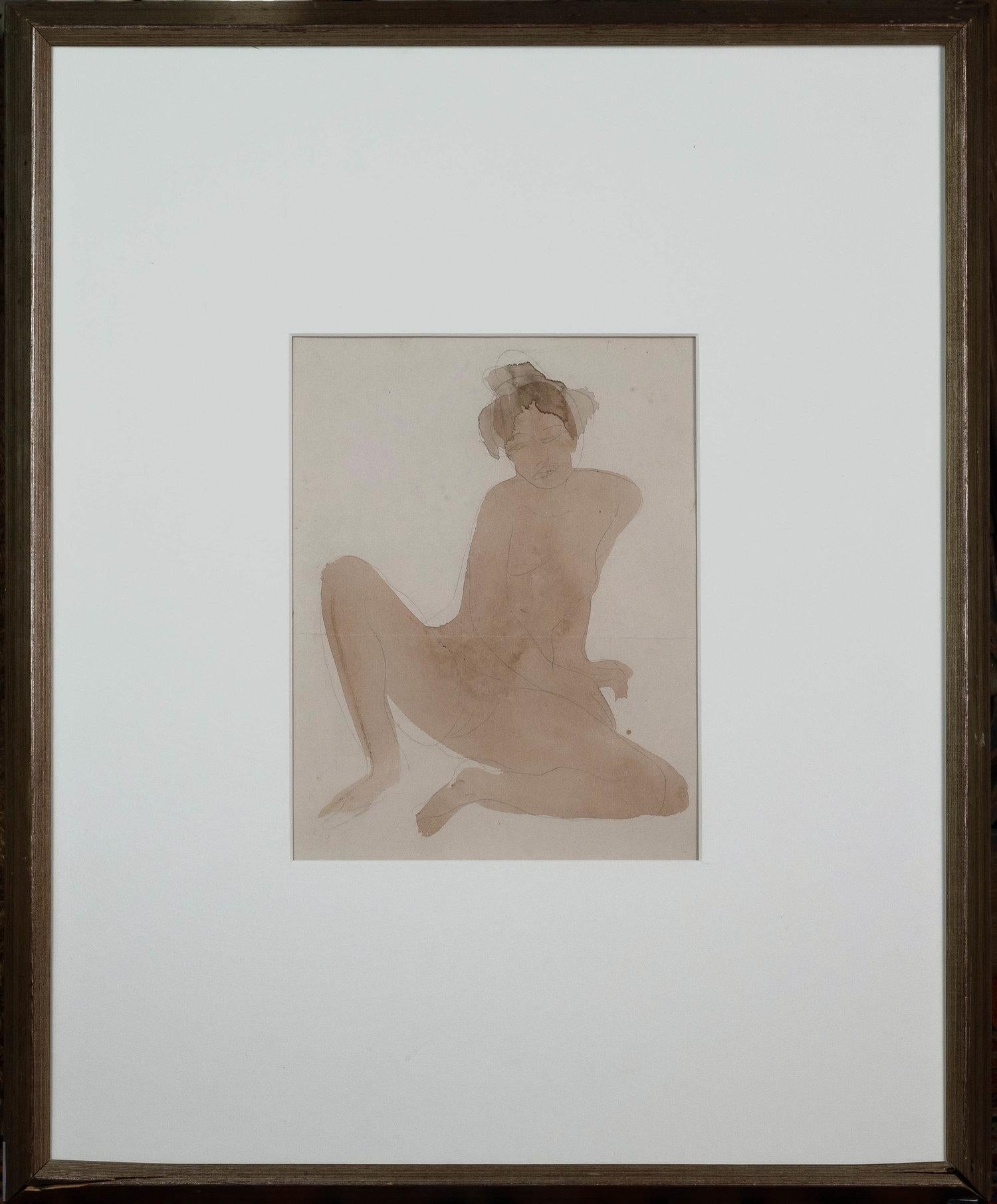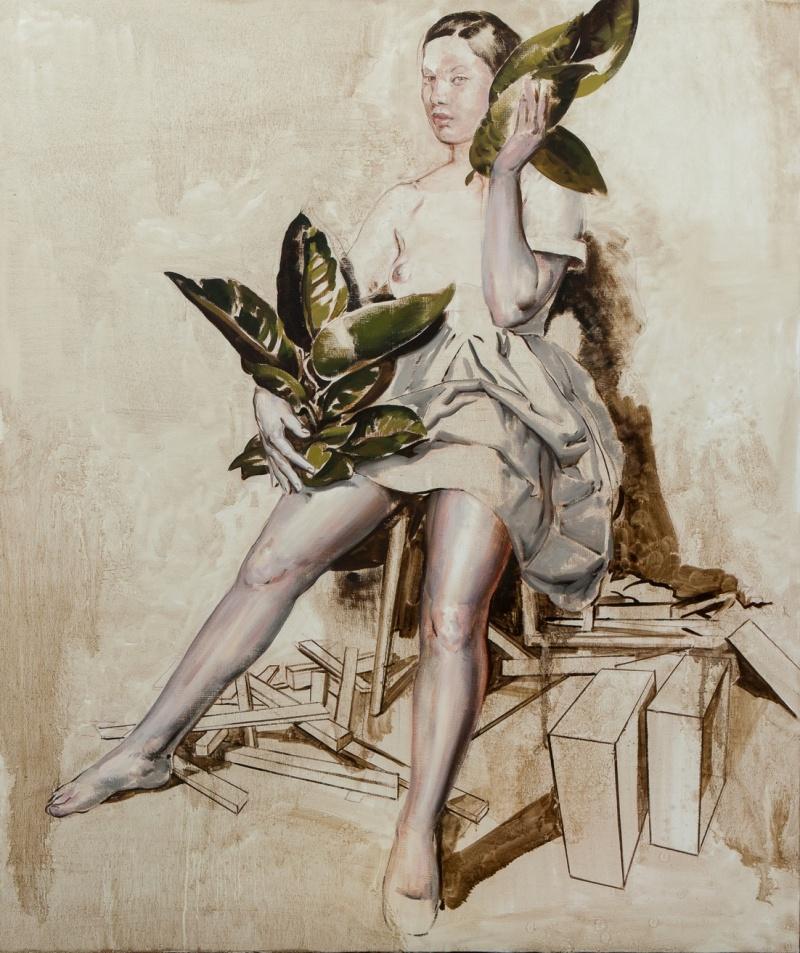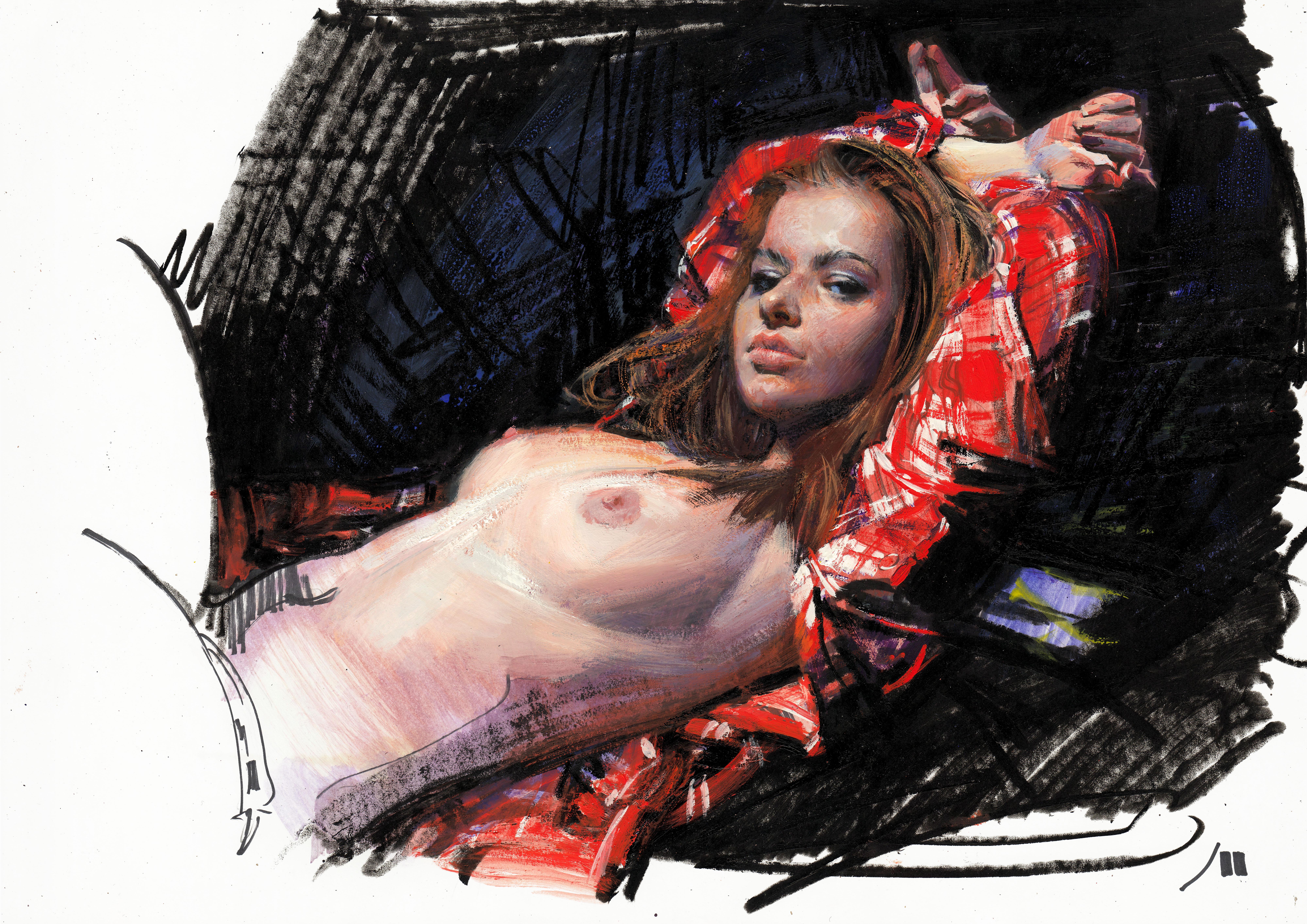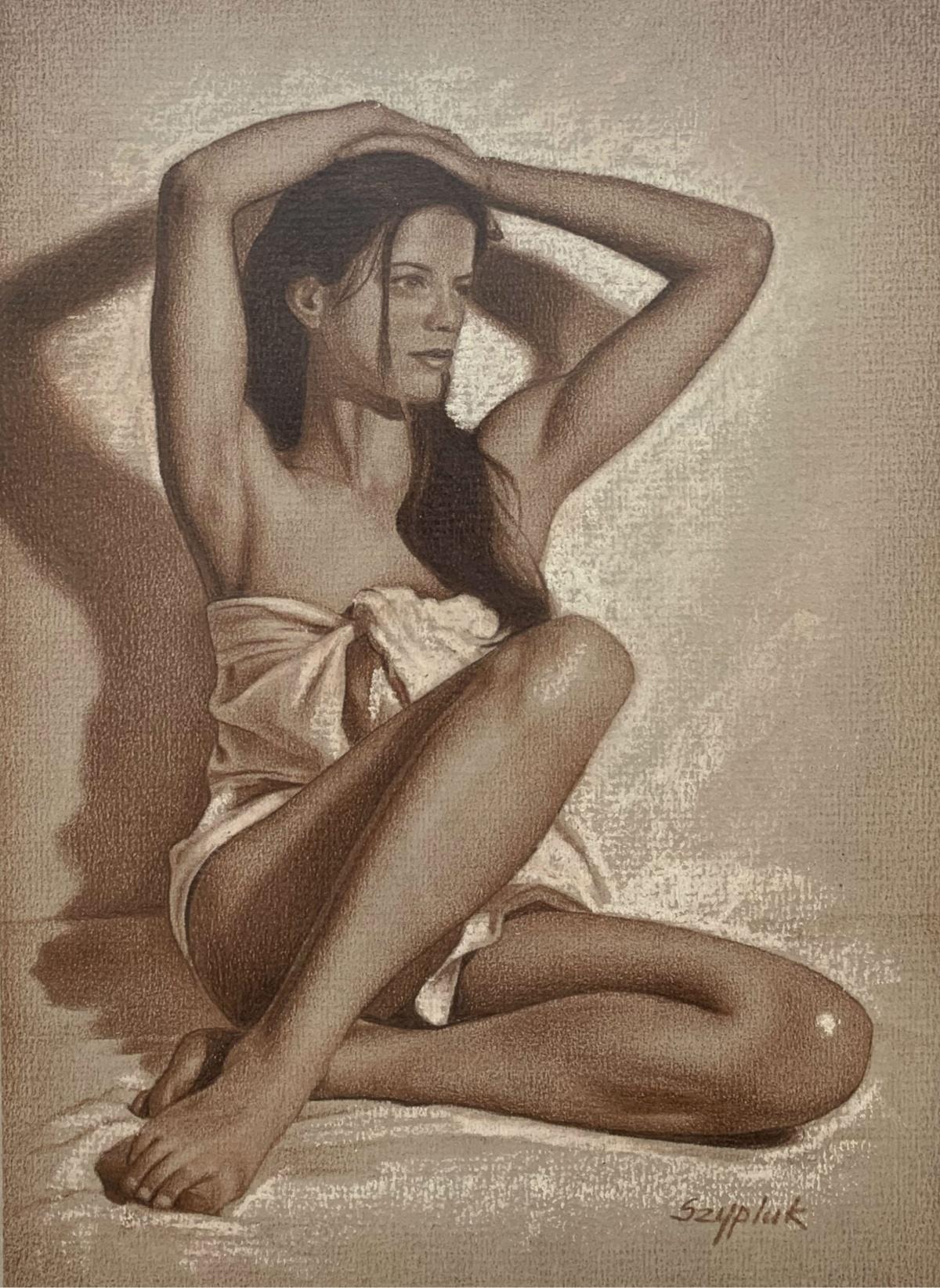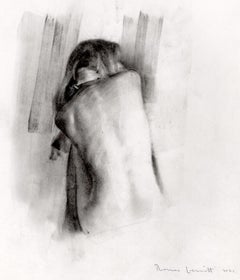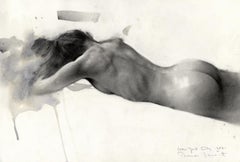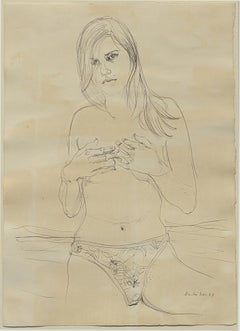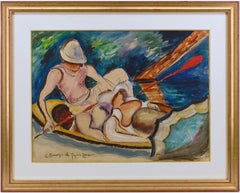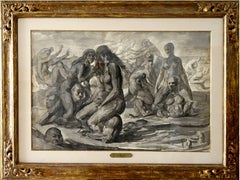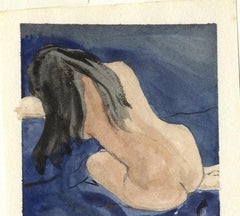
Nude Woman (Long black hair contrasts with the light skin tone of seated nude)
View Similar Items
Want more images or videos?
Request additional images or videos from the seller
1 of 5
Glenora RichardsNude Woman (Long black hair contrasts with the light skin tone of seated nude)circa 1992
circa 1992
About the Item
- Creator:Glenora Richards (1909 - 2009)
- Creation Year:circa 1992
- Dimensions:Height: 2.5 in (6.35 cm)Width: 2.5 in (6.35 cm)
- Medium:
- Movement & Style:
- Period:
- Condition:
- Gallery Location:New Orleans, LA
- Reference Number:1stDibs: LU84134950752
About the Seller
4.9
Gold Seller
These expertly vetted sellers are highly rated and consistently exceed customer expectations.
Established in 1988
1stDibs seller since 2018
752 sales on 1stDibs
Typical response time: 3 hours
Associations
International Fine Print Dealers Association
More From This SellerView All
- Statue of Young Boy in Fountain on the PlazaBy Jackson Lee NesbittLocated in New Orleans, LAThis very early original red conte drawing is signed "Jack L. Nesbitt, 4/21/34". On the back of the drawing, Nesbitt has written "Quick sketch from fountain on Plaza". Jack was a student of Thomas Hart Benton at the Kansas City Art Institute during this period. The figure on the drawing is of a nude young boy with both arms in the air. A very rare early work by this fine artist. Jackson Lee Nesbitt, a noted printmaker and painter of the American Scene, dedicated his artistic career to the portrayal of ordinary people going about the business of their lives. A native of Oklahoma, Nesbitt created scenes from the Midwest during the 1930s and 1940s, but in the 1950s, when interest in his work diminished, he moved to Atlanta and established a second career in advertising. Thirty years later, Nesbitt sold his business and resumed his artistic career from Atlanta. He was born in McAlester, Oklahoma, on June 16, 1913, the only child of LuCena Grant and Howard Nesbitt. The family resided in Muskogee, Oklahoma, where his father owned a commercial printing business. Jack, as Nesbitt was known, helped out in the family business until 1931, when he enrolled at the University of Oklahoma in Norman. Two years later Nesbitt enrolled at the Kansas City Art Institute in Missouri. As a first-year student, he learned etching from John deMartelly, attended Ross Braught's painting class, and met his future wife, Elaine Thompson, who was a costume design student. Thomas Hart Benton, who joined the faculty in the fall of 1935, quickly became a close friend and mentor to the younger artist. In 1937 the management of the Sheffield Steel Corporation contacted deMartelly concerning an etching commission. Because Nesbitt was an outstanding student, his teacher suggested him for the job. When Nesbitt arrived at the plant one afternoon, he was taken to the open-hearth furnace area, where he diligently sketched anonymous workers in that dramatic setting until five o'clock the following morning. On the strength of his sketches, he was commissioned to create a series of etchings illustrating different phases of the steel industry. The commission launched Nesbitt's career as a professional artist. The commission with Sheffield Steel Corporation provided the financial security that enabled Jack and Elaine Nesbitt to marry on June 1, 1938. He graduated from the Kansas City Art Institute about the same time. Working as a freelance artist, Nesbitt augmented his commissioned work with genre scenes of the Midwest, and he routinely went with Benton on sketching trips to rural Arkansas. Beginning in 1939 Nesbitt's work gained widespread recognition. Open Hearth Door, a Sheffield Steel Corporation painting, was chosen to represent Missouri in the American Art Today exhibition at the New York World's Fair. Associated American Artists selected one of his etchings, Watering Place, for an edition of 250 prints that were sold through subscription. Having a print published by the association ensured national distribution, and four more of Nesbitt's works, all of rural southern genre scenes, were later selected by the print publisher. Over the next decade Nesbitt's work was exhibited in California, Colorado, Illinois, Missouri, New York, and Oklahoma. He was awarded the Eames Prize by the Society of American Etchers in 1946, and his work was included in the book American Prize Prints of the Twentieth Century, by Albert Reese. Major corporations with operations in the Midwest, including Brown and Bigelow, Butler Manufacturing Company, Humble Oil and Refining Company, Omaha Steel Works, Pratt and Whitney...Category
1930s American Modern Figurative Drawings and Watercolors
MaterialsConté
- Looking Away (a sensual young woman reflects on her future as she ponders past)By Tom LeverittLocated in New Orleans, LAA pencil drawing Tom Leveritt (1976) was raised in Texas, sent to boarding school in the UK, got a first at Cambridge, an Army Scholarship into the 5th Ro...Category
2010s Modern Figurative Drawings and Watercolors
MaterialsPencil
- Nude woman lyingBy Tom LeverittLocated in New Orleans, LAA pencil drawing with ink wash Tom Leveritt (1976) was raised in Texas, sent to boarding school in the UK, got a first at Cambridge, an Army Scholarship i...Category
2010s Modern Figurative Drawings and Watercolors
MaterialsPencil, Ink
$480 Sale Price20% Off - Choice I (Monochrome-Strong influence of Church's Baroque / Renaissance art )By Radek HusakLocated in New Orleans, LARadek Husak, a contemporary process-driven mixed media artist, was born in Poland in 1984. With a Master’s degree from the Royal College of Art, his practice is firmly situated in th...Category
21st Century and Contemporary Pop Art Figurative Drawings and Watercolors
MaterialsPencil, Pigment
- Nude Man and Woman (Desire and sexual tension)By Tom LeverittLocated in New Orleans, LAIs it lust? Is it love? A pencil drawing shows a nude man and a nude woman on the same page. Sexual tension and desire are paramount in this composition. Tom Leveritt...Category
2010s Modern Figurative Drawings and Watercolors
MaterialsCharcoal
$417 Sale Price44% Off - Male Lying NudeBy Jackson Lee NesbittLocated in New Orleans, LAThis is a drawing from the artist's sketchbooks. This pencil drawing shows a nude male in repose, The drawing is dated November 30 '36 (1936). Clearly the works are authentic and this sketch is signed "Jackson Lee Nesbitt...Category
Late 20th Century American Modern Nude Drawings and Watercolors
MaterialsGraphite
You May Also Like
- untitled / ohne TitelBy Martin EderLocated in New York, NYMartin Eder untitled work on paper executed in ballpoint pen with traces of watercolor. Ohne Titel Arbeit auf Papier, ausgeführt in Kugelschreiber mit Spuren von Aquarell. 2007Category
Early 2000s Realist Nude Drawings and Watercolors
MaterialsInk, Watercolor, Pen
- "Boating on the Morin River"By André Dunoyer de SegonzacLocated in Saint Amans des cots, FRPen, ink, watercolor and wash on paper by André Dunoyer de Segonzac, France, 1922-1924. Boating on the Morin River. Measurements : with frame: 52.5x65x2 cm - 20.7x25.6x0.8 inches / without frame: 36.5x45 cm - 14.4x17.7 inches. Signed lower left "A. Dunoyer de Segonzac". Colors may vary slightly depending on your screen. The lighter band at the top and the bottom of the piece, visible in the first picture, is only due to the reflection in the protective glass. It does not exist. In its frame gilt with gold leaf and its protective glass. André Dunoyer de Segonzac was born in Boussy-Saint-Antoine (Essonne) July 7, 1884. After his schooling at high school Henri IV, as early as 1900, he attends classes at the National School of Fine Arts in Paris in free listener where he will befriend Charles Dufresne. In 1903, he enters the private studio of Luc-Olivier Merson. In 1907, he studies with Jean-Paul Laurens and attends the La Palette and Colarossi academies in Montparnasse. He meets Luc-Albert Moreau and Jean-Louis Boussingault with whom he shares a studio. His first drawings are published in 1908 in The Great Review and The Witness. Nearly indifferent to contemporary aesthetic revolutions, Dunoyer de Segonzac undertakes, with Jean-Louis Boussingault and Luc-Albert Moreau, to revive Gustave Courbet's realism by performing still lifes, nudes, landscapes, in a thick paste and masonry . In one of his letters to the painter Maurice Boitel, he wrote in the 1950s: "I have not forgotten the heroic period of the independents - when we were grouped around Paul Signac, the charming and valiant Maximilien Luce - in these barracks where the living and authentic Art was grouped outside the academic formulas - or literary and systematic tendencies - which were to lead to this abstract aesthetic of which the painting dies. " In 1908, he begins exhibiting at the Salon d'Automne and the Salon des Indépendants, with Paul Signac and Maximilien Luce. He befriends Apollinaire, Max Jacob, Raoul Dufy and Vlaminck. From this period, renting a house belonging to Signac, Dunoyer discovers the landscapes of Saint-Tropez, to which he will remain faithful and where he lived until the end of his life. He stays in Saint-Tropez only in the summer season. For the rest, he leads a real nomadic life, in search of the motive especially through the Île-de-France, the Grand Morin valley, Feucherolles, Chennevières-sur-Marne, Guyancourt, etc. "I also worked a lot on the banks of the Seine in Chatou, Bougival, Andrésy, Poissy and Triel that I particularly like, with its beautiful Gothic church that is reflected in the Seine and the high wooded hills that surround him", he will say. In 1910, he knows fashion designer Paul Poiret and meets Max Jacob, Raoul Dufy and Vlaminck. From 1910 to 1914, he travels to Italy, Spain, North Africa, and is interested in sport and dance (drawings of Isadora Duncan's Russian Ballets, 1911, The Boxers1910). From 1914 to 1918, mobilized in the infantry, he makes the war hardly, before being assigned to camouflage. He performs many war drawings, valuable for their artistic and documentary value. From 1919, he appears again in many exhibitions, including major Parisian salons. Nearly indifferent to contemporary aesthetic revolutions, Dunoyer de Segonzac undertakes, with Boussingault and Moreau, to revive Courbet's realism by performing still lifes, nudes, landscapes, in a thick and masonry paste. Enlisted in engraving by Jean Émile Laboureur, he makes nearly 1,600 brass plaques from 1919 to 1970. He was president of the Society of French painters-engravers. In 1921, he meets Paul Valéry, Léon-Paul Fargue and Jean Cocteau. In 1928, he makes a trip to America where he met with great success. In 1930, he becomes friend with Derain. In 1933 he receiveds the Carnegie Foundation of Pittsburgh Award and in 1934 the Venice Biennale. During the Occupation, in November 1941, he takes part in a "study trip" to Germany, organized by Arno Breker, accepting, like other artists of the most renowned, to visit the hotspots of German culture as well as artist workshops. After the war, he is exhibited in the best galleries...Category
1920s Realist Figurative Drawings and Watercolors
MaterialsPaper, Ink, Watercolor, Pen
- Water Sports - Nude Swimmers and Bathers at Coney IslandBy Reginald MarshLocated in Miami, FLHistorically, academic artists have always featured the central figures in their composition in a prominent light with the background figures being darker. In water sports...Category
1940s Realist Figurative Drawings and Watercolors
MaterialsIndia Ink, Watercolor
- "The Dance, " Ludovico Lipparini, graphite, gouache, mythological, classicalLocated in Wiscasset, ME"The Dance" by Ludovico Lipparini is a beautifully rendered work on paper in the classical tradition using graphite and gouache and created in the f...Category
Early 19th Century Realist Figurative Drawings and Watercolors
MaterialsGraphite, Paper, Gouache
- BallerinaBy Charles KifferLocated in San Francisco, CAThis artwork titled "Ballerina" c.1950 is a watercolor on paper by French noted artist Charles Kiffer, 1902-1992. It has the estate stamp of the artist on the back. The artwork size ...Category
Mid-20th Century Realist Figurative Drawings and Watercolors
MaterialsWatercolor
- Rare Rodin Watercolour & Pencil on Paper of a Seated Nude - The Cambodian DancerBy Auguste RodinLocated in London, GBAuguste RODIN (1840-1917) Seated Nude, Cambodian Dancer c. 1898 - 1900 Pencil and watercolour 11.5 x 9.3 inches; 25 x 20.5 inches, inc. frame Provenance: Christie's South Kensington: Wednesday, November 28, 2007 "It's very simple. My drawings are the key of my art." Rodin was an extraordinary creative artist and a prolific worker. After attending the “Petite École”, he worked in the studio of the ornamentalist Albert-Ernest Carrier-Belleuse, first in Paris, then in Brussels, where his skill in handling decorative subjects fashionable in the 18th century became apparent. His discovery of Michelangelo, during a visit to Italy in 1875-76, was a decisive moment in his career. Rodin would, in turn, break new ground in sculpture, paving the way for 20th-century art, by introducing methods and techniques that were central to his own artistic aesthetics. In 1906, King Sisowath of Cambodia visited France on an official state visit. It was on this visit that Rodin discovered the dancers of the Cambodian Royal Ballet and was inspired to draw and paint them over 150 times. They made a deep impression on the artist, as he confided to Georges Bourdon, in an article for the newspaper Le Figaro on 1 August 1906: “There is an extraordinary beauty, a perfect beauty, about these slow, monotonous dances, which follow the pulsating rhythm of the music… [The Cambodians] have taught me movements I had never come across anywhere before…” Originally seeing them in Paris he left everything suddenly to follow the dancers of the royal ballet to Marseille, from where they would embark on their return to Cambodia. In just one week, he made about one hundred and fifty drawings, re-transcribing or interpreting the ballet poses, with an obvious fascination for the arms and hands of the dancers. These drawings were later highlighted with watercolour, creating coloured harmonies of a rare refinement. The first performance of the Cambodian Royal Ballet took place in the context of the Colonial Exhibition in Marseille. Sisowath 1st had just been crowned King of Cambodia when he undertook the first trip ever to be made by a Cambodian sovereign to France, which had controlled Cambodia since June 1884. This official visit occurred at the height of French colonial expansion. Previously, the Universal Exhibition of 1900 had attracted 48 million visitors! The organisers realised what a tremendous impact this event made on the public, and it was soon adopted as the main tool for colonial propaganda. At the exhibition in Marseilles, the area devoted to Indochina was the largest of the seven sections. When Auguste Rodin met the troupe of dancers for the first time in July 1906, during their brief visit to Paris for an exceptional performance at the Pré Catalan...Category
19th Century Realist Figurative Drawings and Watercolors
MaterialsWatercolor
